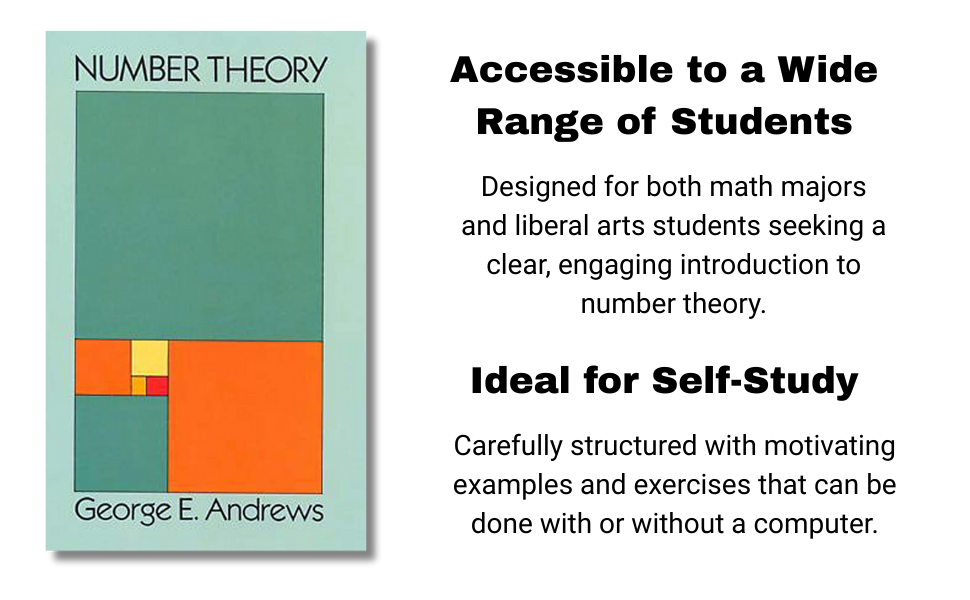Customer Services
Copyright © 2025 Desertcart Holdings Limited
Desert Online General Trading LLC
Dubai, United Arab Emirates


Full description not available

J**R
Fresh Air
I recently took a one-semester course using this text. I found it to be one of the best textbooks I've used so far. The exposition was clear and easy to digest, with just the right number of clarifications and examples. The exercises were numerous, challenging and illuminating. No background beyond very basic set theory is assumed, and in fact the writer goes very far out of his way to keep his exposition separate from abstract algebra. This is most evident in the chapter on primitive roots. I can't speak for the second half of the book, on additivity, but I can say with certainty that the first nine chapters are worth the effort.
D**R
Excellent text by expert in the field
George Andrews is the reigning expert on partitions in the mathematical community who has written many seminal papers on the subject over the past half-century! If you don't know what partitions are in the theoretical sense, don't worry, the text provides ample introduction. I don't think you can find a more elementary introduction to the difficult, but extraordinarily powerful and elegant theory of partitions. The book covers the basics of number theory well, but it is the chapters on partitions that make this text stand out. It covers the Rogers-Ramanujan identities as well as the Jacobi triple product identity. It is rare in the mathematical community that an expert in a subject also writes a ground-level introductory text - but that's what you have here. Thanks to the dover edition, it's now quite affordable.
N**E
Might as well be renamed 'Combinatorial Number Theory'
A few years ago, I read this book by George Andrews of Penn State University into chapter 8 and this 1971 textbook by him already shows his long interest in both combinatorics and number theory. Where I stopped reading was when the author's proofs started being multiple pages long.Here are the titles of the chapters with their starting pages:// PART I Multiplicativity-Divisibility // 1. Basis Representation-3 / 2. The Fundamental Theorem of Arithmetic-12 / 3. Combinatorial and Computational Number Theory-30 / 4. Fundamentals of Congruences-49 / 5. Solving Congruences-58 / 6. Arithmetic Functions-75 / 7. Primitive Roots-93 / 8. Prime Numbers-100 // PART II Quadratic Congruences // 9. Quadratic Residues-115 / 10. Distribution of Quadratic Residues-128 // PART III Additivity // 11. Sums of Squares-141 / 12. Elementary Partition Theory-149 / 13. Partition Generating Functions-160 / 14. Partition Identities-175 // PART IV Geometric Number Theory // 15. Lattice Points-201 / There are four mathematical appendices and the full set of indices after the 15 chapters--213-259.From the complicated table of contents above, one can see a broad sweep of combinatorial number theory. Part I is mostly pretty straight number theory, and that is what I did read. Part III on additivity is almost fully combinatorics more than number theory though. Still the price of this book is quite low to have access to all of this big range of mathematics to pick and choose what is most interesting to any given reader. Recommended.
J**A
Fun to read
Definitely not an easy read, but it was lots of fun and I liked it.
J**S
Excellent Reference
Excellent book for the subject
T**I
Interesting inclusion of computers
Number theory is both easy and difficult. This book does a good job of highlighting some of these aspects in a clear and straightforward way. It also does a good job of discussing the role technology is playing for some in the field today.
K**Y
Take this with salt
Good book if you have someone with you but it has a really hard introduction. The proof is not for the faint of heart and is beautiful if you understand it but I would recommend a different book (probably not from springer either if you are self teaching lol)./
T**D
Number Theory from a Different Viewpoint
I had a number theory class back in the dark ages when i was studying Mathematics at OSU. Before I started this book I reviewed another number theory book. It was like deja vu - the method was exactly what I had seen before. In fact, it may have been the same book. Then I picked this up to go a little more in depth. I was a little thrown off at first. Pretty much the same things were covered but from such a vastly different angle it almost seemed like a whole different field of mathematics.I can't say which viewpoint is the correct one (they both are, I guess) but, since the books are so inexpensive, I would suggest try each or using both. It is often eye-opening to see the same conclusion derived from attacking the problem from more than one angle.
Trustpilot
3 weeks ago
5 days ago